Impact of Temperature on Low-Cycle Fatigue Characteristics of the HR6W Alloy
Abstract
:1. Introduction
2. Materials and Methods
3. Results and Discussion
4. Conclusions
- The low-cycle fatigue (LCF) life of HR6W at room temperature, expressed as the number of cycles (Nf) to fracture, increased several times as compared with its fatigue life at the temperature of 650 °C, depending on the strain range Δεt used in the fatigue tests. The increase is approximately three fold with a greater strain range (Δεt = 1.0 ÷ 1.2%) and approximately four fold with a smaller stain range (Δεt = 0.6 ÷ 0.8%) used in the fatigue tests.
- Under low-cycle fatigue (LCF) conditions at 650 °C, the fatigue life of HR6W alloy decreased approximately four times from Nf = 3377 to 834 cycles, with a double increase in the total strain range from Δεt = 0.6% to 1.2%. On the other hand, at room temperature, the tests showed an approximately 5-fold reduction in fatigue life from Nf = 13,890 to 2630 cycles, with a similar increase in total strain range Δεt.
- HR6W alloy shows cyclical strengthening both at room temperature and 650 °C. At elevated temperature, strengthening is significantly greater. It is characterized by a greater increase in stress values σan along the decrease in strain amplitude εapl. In this case, the value of the cyclic strength factor K’ = 1403.9 MPa and the cyclic strengthening factor n’ = 0.1709 are significantly higher than those determined for room temperature (K’ = 717.62 MPa and n’ = 0.0992, respectively).
- Analyzing the results of the research on the fatigue of the low-cycle HR6W alloy at the temperature of 650 °C, the process of cyclic hardening of the HR6W alloy is clearly visible. Such behavior of this material is mainly related to the processes of precipitation strengthening taking place in its structure at the boundaries of its grains, in the form of carbides M23C6.
Author Contributions
Funding
Institutional Review Board Statement
Informed Consent Statement
Data Availability Statement
Conflicts of Interest
References
- Abe, F. Development of creep-resistant steels and alloys for use in power plants. In Structural Alloys for Power Plants Operational Challenges and High-Temperature Materials; Shirzadi, A., Jackson, S., Eds.; Woodhead Publishing Series in Energy; Woodhead Publishing: Sawston, UK, 2014; pp. 250–293. [Google Scholar] [CrossRef]
- Hernas, H.; Dobrzański, J.; Pasternak, J.; Fudali, S. Charakterystyki Nowej Generacji Materiałów dla Energetyki; Wydawnictwo Politechniki Śląskiej: Gliwice, Poland, 2015. (In Polish) [Google Scholar]
- Yin, Y.; Faulkner, R.; Starr, F. Austenitic steels and alloys for power plants. In Structural Alloys for Power Plants; Shirzadi, A., Jackson, S., Eds.; Woodhead Publishing: Sawston, UK, 2014; pp. 107–152. [Google Scholar] [CrossRef]
- Chenga, L.-Y.; Wanga, R.-Z.; Wanga, J.; Zhub, S.-P.; Zhaoa, P.-C.; Miurac, H.; Zhanga, X.-C.; Tua, S.-T. Cycle-dependent creep-fatigue deformation and life predictions in a nickel-based superalloy at elevated temperature. Int. J. Mech. Sci. 2021, 206, 106628. [Google Scholar] [CrossRef]
- Gianfrancesco, A.D. New Japanese Materials for A-USC Power Plants Materials for Ultra-Supercritical and Advanced Ultra-Supercritical Power Plants; Woodhead Publishing: Sawston, UK, 2017; pp. 423–468. [Google Scholar] [CrossRef]
- Okrajni, J.; Twardawa, M.; Mutwil, K.; Junak, G. Badania wytrzymałości i trwałości elementów rurociągów energetycznych. In Maszyny i Urządzenia Energetyczne Węglowych Bloków na Wysokie Parametry Pary; Chmielniak, T., Rusin, A., Eds.; Wydawnictwo Politechniki Śląskiej: Gliwice, Poland, 2015; pp. 374–492. (In Polish) [Google Scholar]
- Abe, F. Research and Development of Heat-Resistant Materials for Advanced USC Power Plants with Steam Temperatures of 700 °C and Above. Engineering 2015, 1, 211–224. [Google Scholar] [CrossRef] [Green Version]
- Metzger, K.; Czychon, K.-H.; Zickler, S.; Maile, K. Experience with the Operation of a —RIG for 700 °C Power Plant Materials. Procedia Eng. 2013, 55, 470–473. [Google Scholar] [CrossRef] [Green Version]
- Semba, H.; Okada, H.; Yonemura, M.; Igarashi, M. Creep Strength and Microstructure in 23Cr-45Ni-7W Alloy (HR6W) and Ni-base Superalloys for Advanced. In Proceedings of the 34th MPA-Seminar Materials and Components Behaviour in Energy & Plant Technology, Stuttgart, Germany, 9–10 October 2008. [Google Scholar]
- Cempura, G.; Rutkowski, B.; Rydel, J.J.; Cieszyński, K.; Czyrska-Filemonowicz, A. Microstructural evolution of HR6W alloy during ageing at high temperature. Inżynieria Mater. 2016, 5, 211–216. [Google Scholar] [CrossRef]
- Tokairin, T.; Dahl, K.V.; Danielsen, H.K.; Grumsen, F.B.; Sato, T.; Hald, J. Investigation on long-term creep rupture properties and microstructure stability of Fe–Ni based alloy Ni–23Cr–7W at 700 °C. Mater. Sci. Eng. A 2013, 565, 285–291. [Google Scholar] [CrossRef]
- Iwamaru, A.; Hisazawa, H.; Terada, Y. Microstructure Evolution of Fe-Ni-Based Alloy HR6W during Isothermal Aging. Mater. Trans. 2019, 60, 824–829. [Google Scholar] [CrossRef] [Green Version]
- Cui, S.; Zhang, Z.; Xu, Y.; Li, J.; Xiao, X.; Zhu, C. Improvement of Stress-rupture Life for Modified-HR6W Austenitic Stainless Steel. J. Mater. Sci. Technol. 2011, 27, 1059–1064. [Google Scholar] [CrossRef]
- Jinga, H.; Luoa, Z.; Xua, L.; Zhaoa, L.; Hana, Y. Low cycle fatigue behavior and microstructure evolution of a novel 9Cr–3W–3Co tempered martensitic steel at 650 °C. Mater. Sci. Eng. A 2018, 731, 394–402. [Google Scholar] [CrossRef]
- Azeeza, A.; Erikssona, R.; Calmunger, M. Characterisation of deformation and damage in a steam turbine steel subjected to low cycle fatigue. Procedia Struct. Integr. 2019, 23, 155–160. [Google Scholar] [CrossRef]
- León-Cázares, F.D.; Monni, F.; Jackson, T.; Galindo-Nava, E.I.; Rae, C.M.F. Stress response and microstructural evolution of nickel-based superalloys during low cycle fatigue: Physics-based modelling of cyclic hardening and softening. Int. J. Plast. 2020, 128, 102682. [Google Scholar] [CrossRef]
- Viswanathana, R.; Colemana, K.; Raob, U. Materials for ultra-supercritical coal-fired power plant boilers. Int. J. Press. Vessel. Pip. 2006, 83, 778–783. [Google Scholar] [CrossRef]
- Zhang, T.; Wang, X.; Ji, Y.; Tang, J.; Jiang, Y.; Zhang, X.; Gong, J. Cyclic deformation and damage mechanisms of 9%Cr steel under hybrid stress-strain controlled creep fatigue interaction loadings. Int. J. Fatigue 2021, 151, 1–14. [Google Scholar] [CrossRef]
- Turka, A.; Bombac, D.; Rydel, J.J.; Ziętara, M.; Rivera-Díaz-del-Castillo, P.E.J.; Galindo-Nava, E.I. Grain boundary carbides as hydrogen diffusion barrier in a Fe-Ni alloy: A thermal desorption and modelling study. Mater. Des. 2018, 160, 985–998. [Google Scholar] [CrossRef]
- Noguchi, Y.; Okada, H.; Semba, H.; Yoshizawa, M. Isothermal, Thermo-Mechanical and Bithermal Fatigue Life of Ni Base Alloy HR6W for Piping in 700 °C USC Power Plants. Procedia Eng. 2011, 10, 1127–1132. [Google Scholar] [CrossRef] [Green Version]
- Yin, P.; Zhang, W.; Guo, S.; Wen, J.; Zhang, G.; Xue, F.; Zhao, Y.; Zhou, C. Thermomechanical fatigue behaviour and damage mechanisms in a 9% Cr steel: Effect of strain rate. Mater. Sci. Eng. A 2021, 815, 141308. [Google Scholar] [CrossRef]
- Gong, X.; Wang, T.; Li, Q.; Liu, Y.; Zhang, H.; Zhang, W.; Wang, Q.; Wang, Q. Cyclic responses and microstructure sensitivity of Cr-based turbine steel under different strain ratios in low cycle fatigue regime. Mater. Des. 2021, 201, 109529. [Google Scholar] [CrossRef]
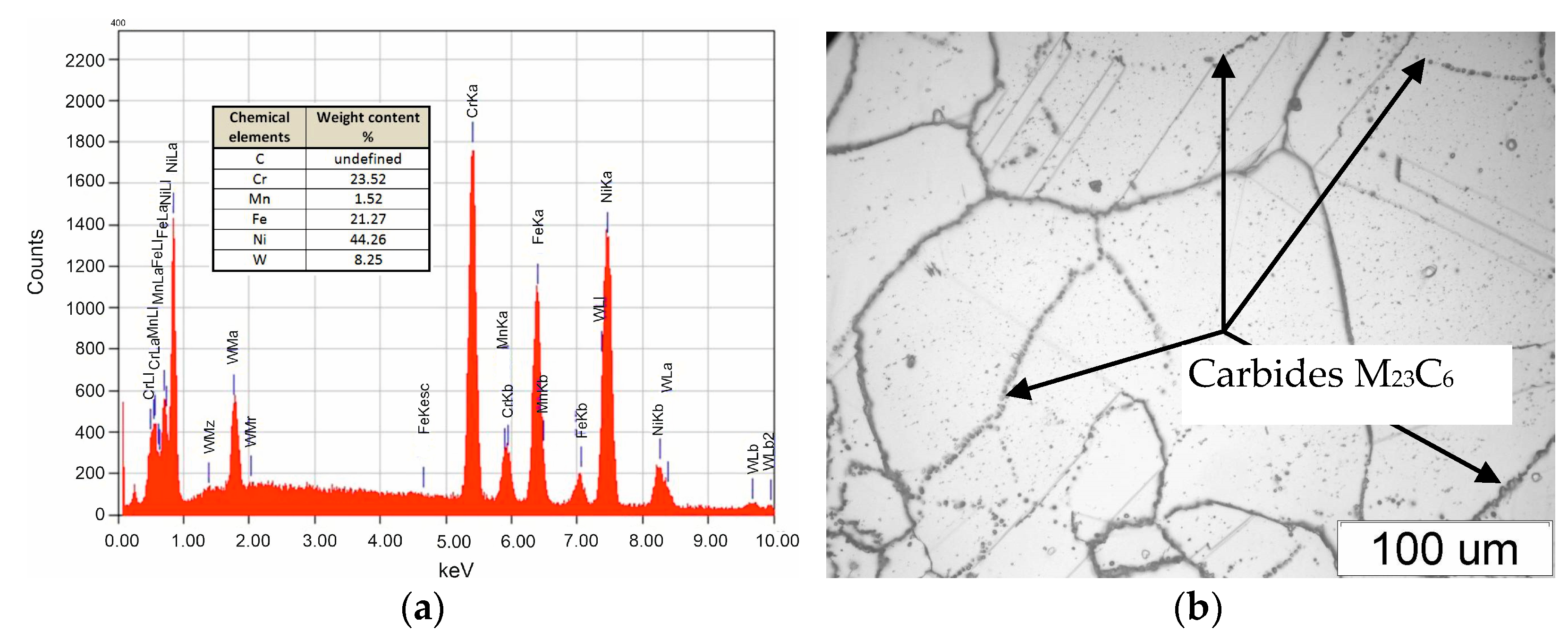
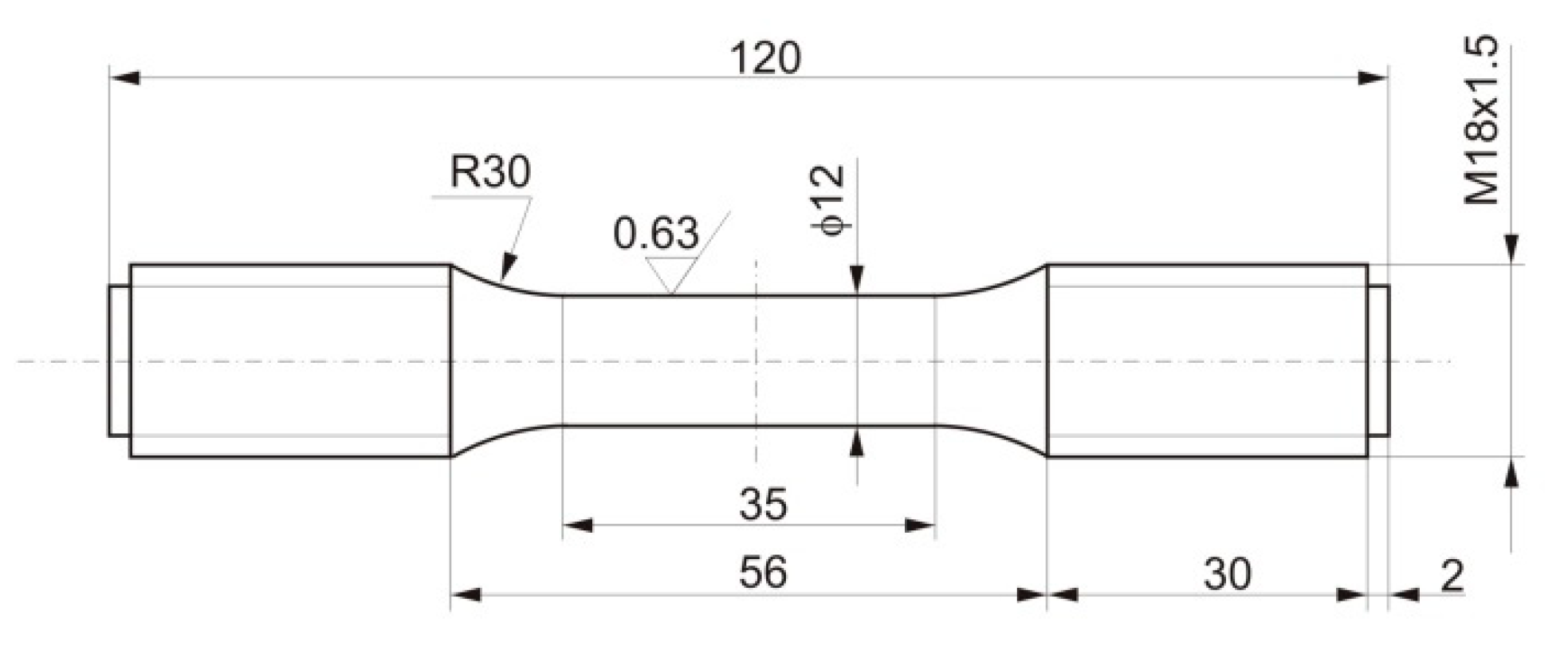

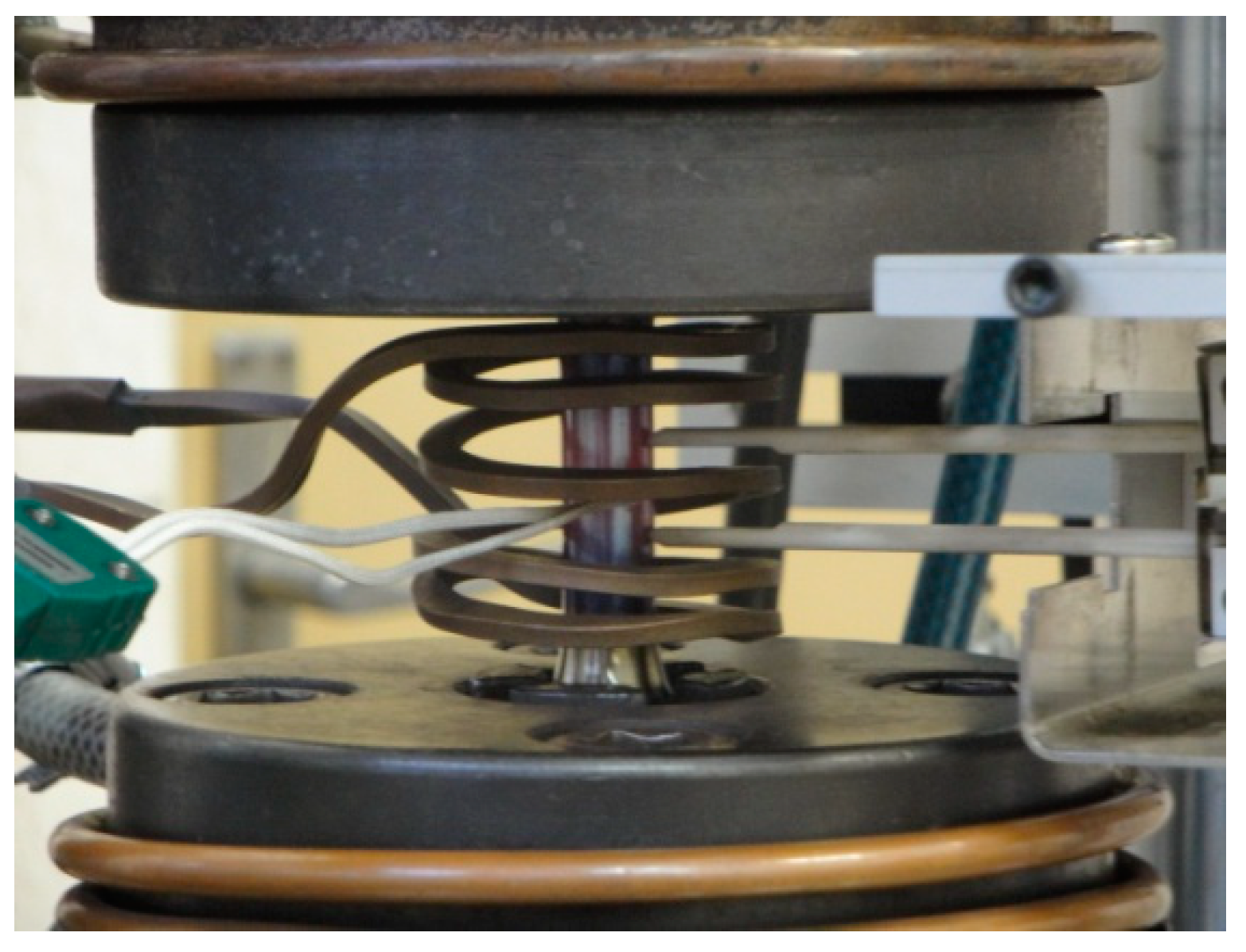

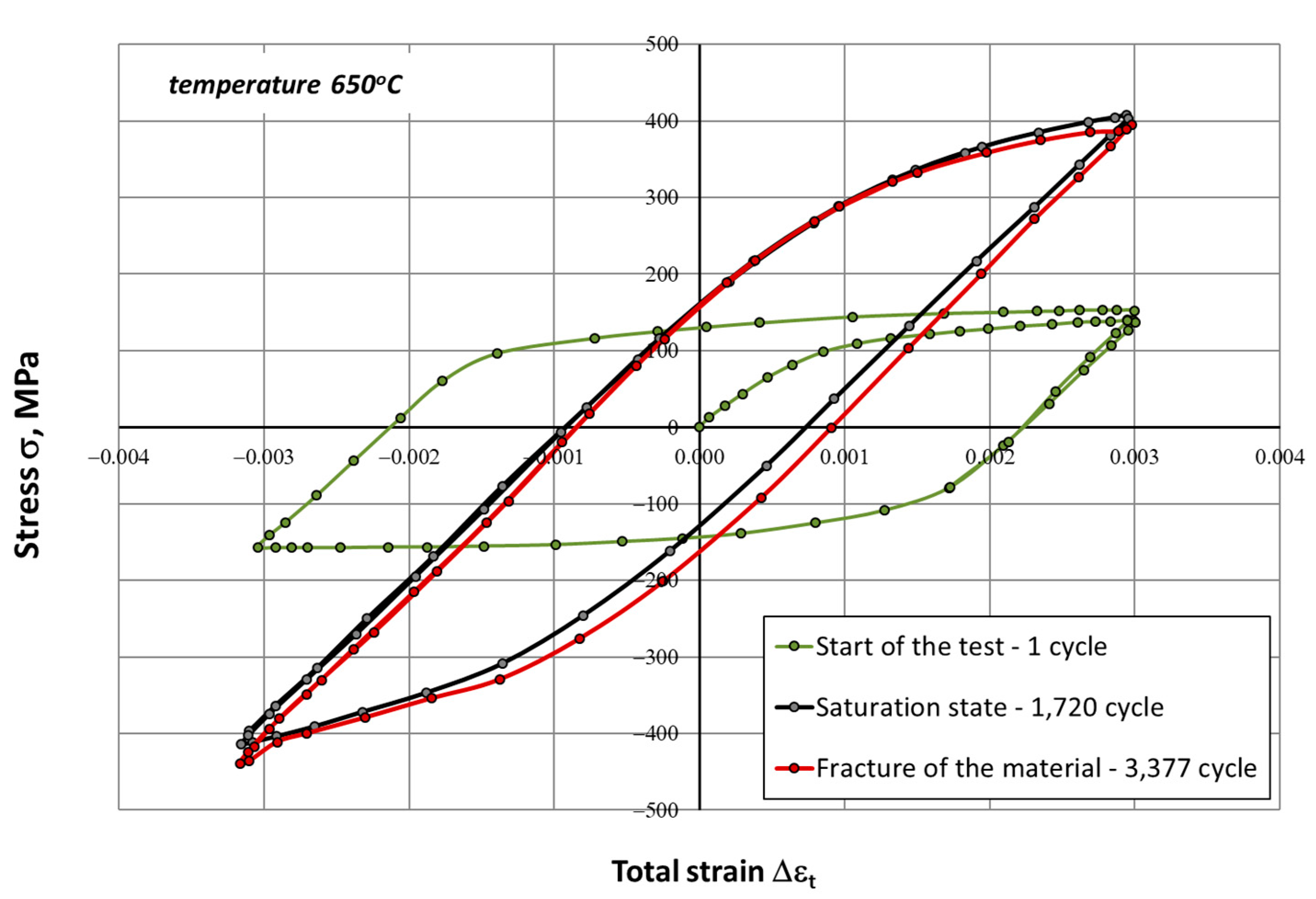
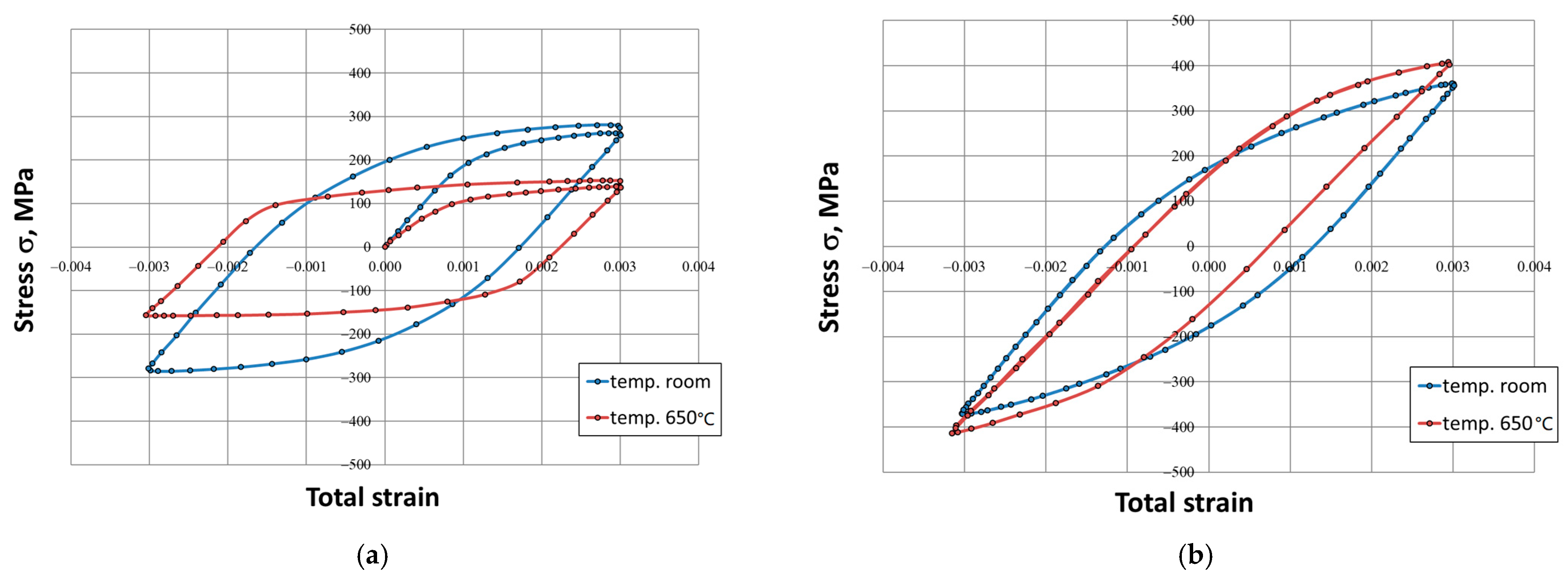
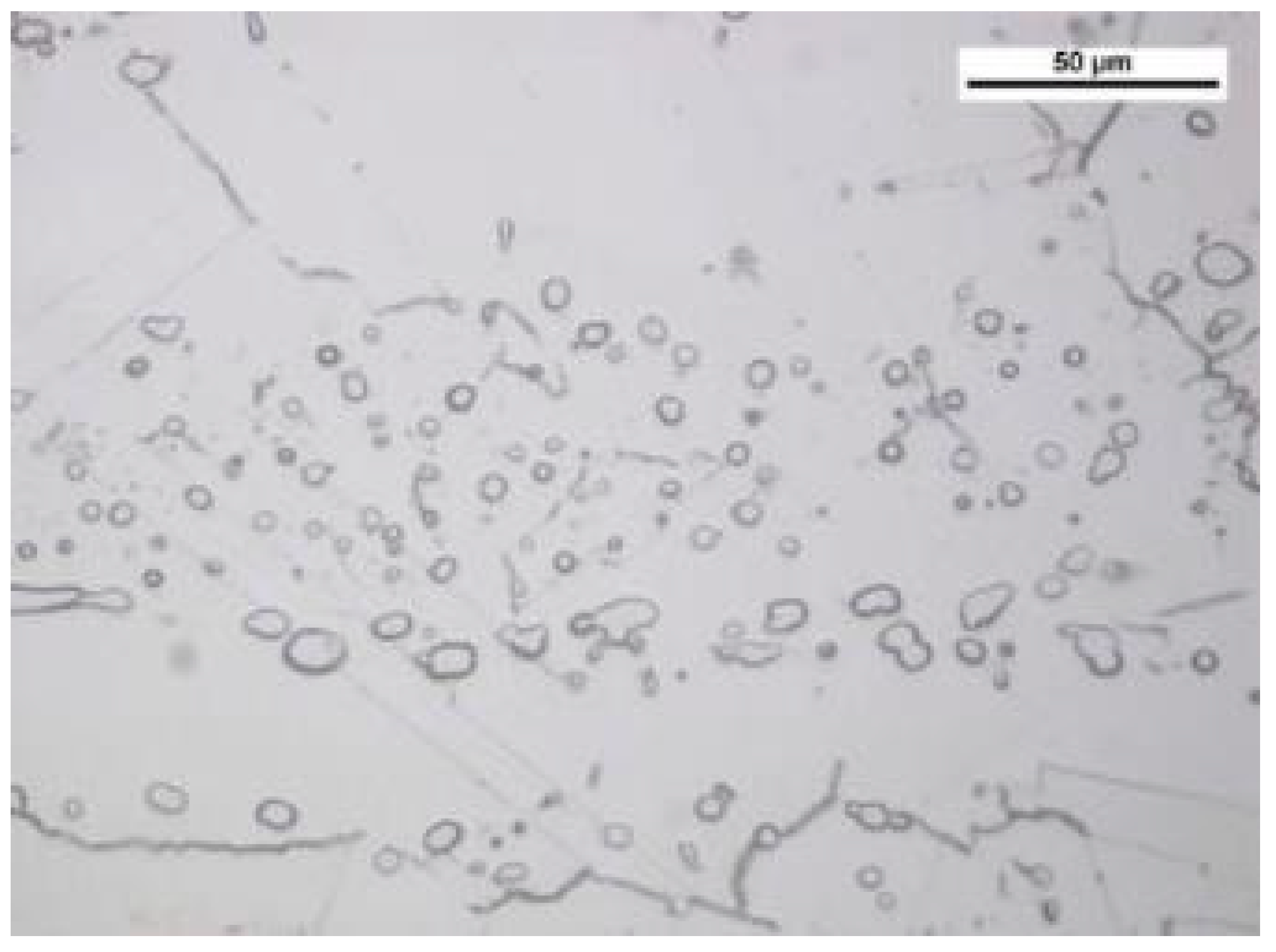
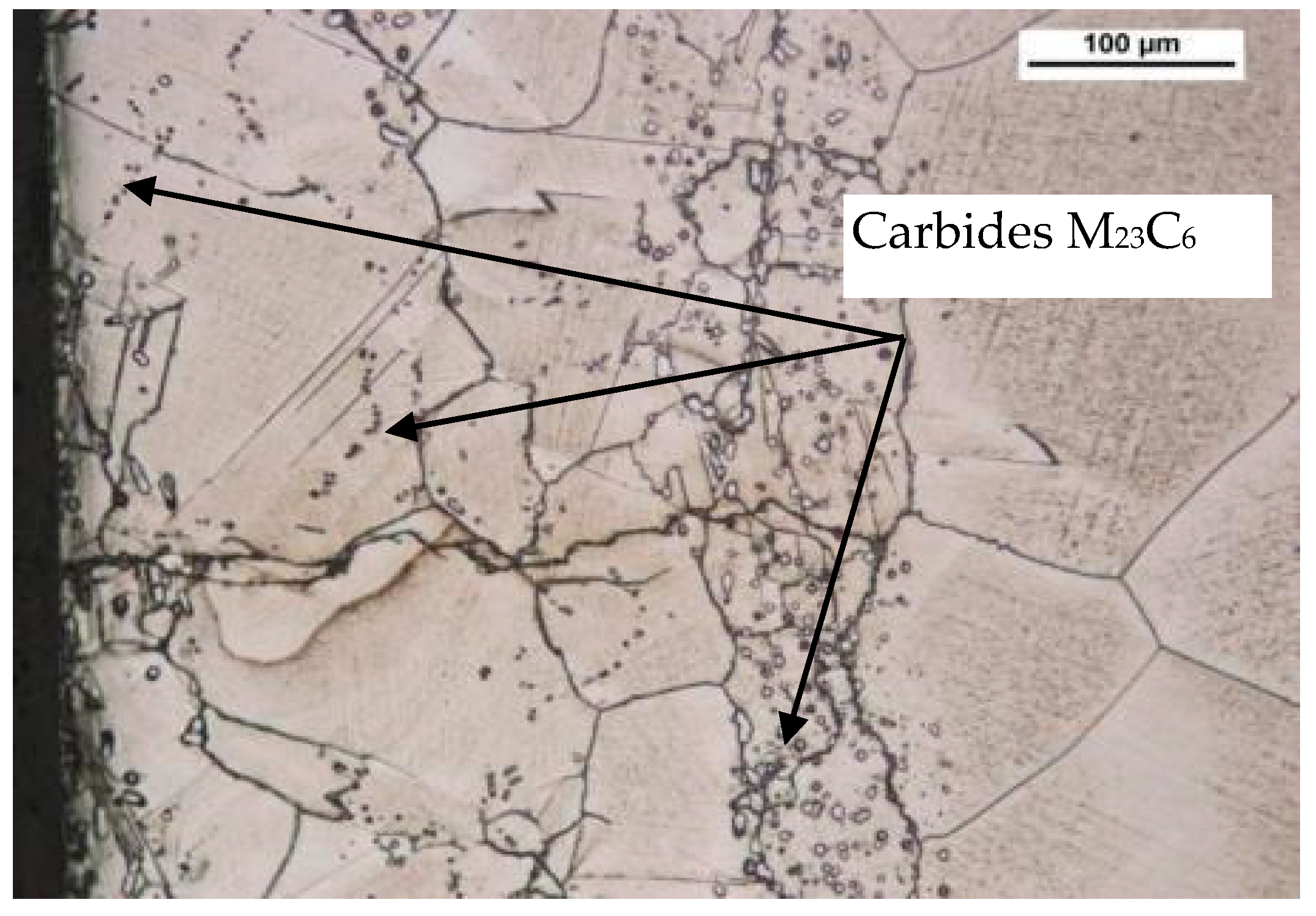
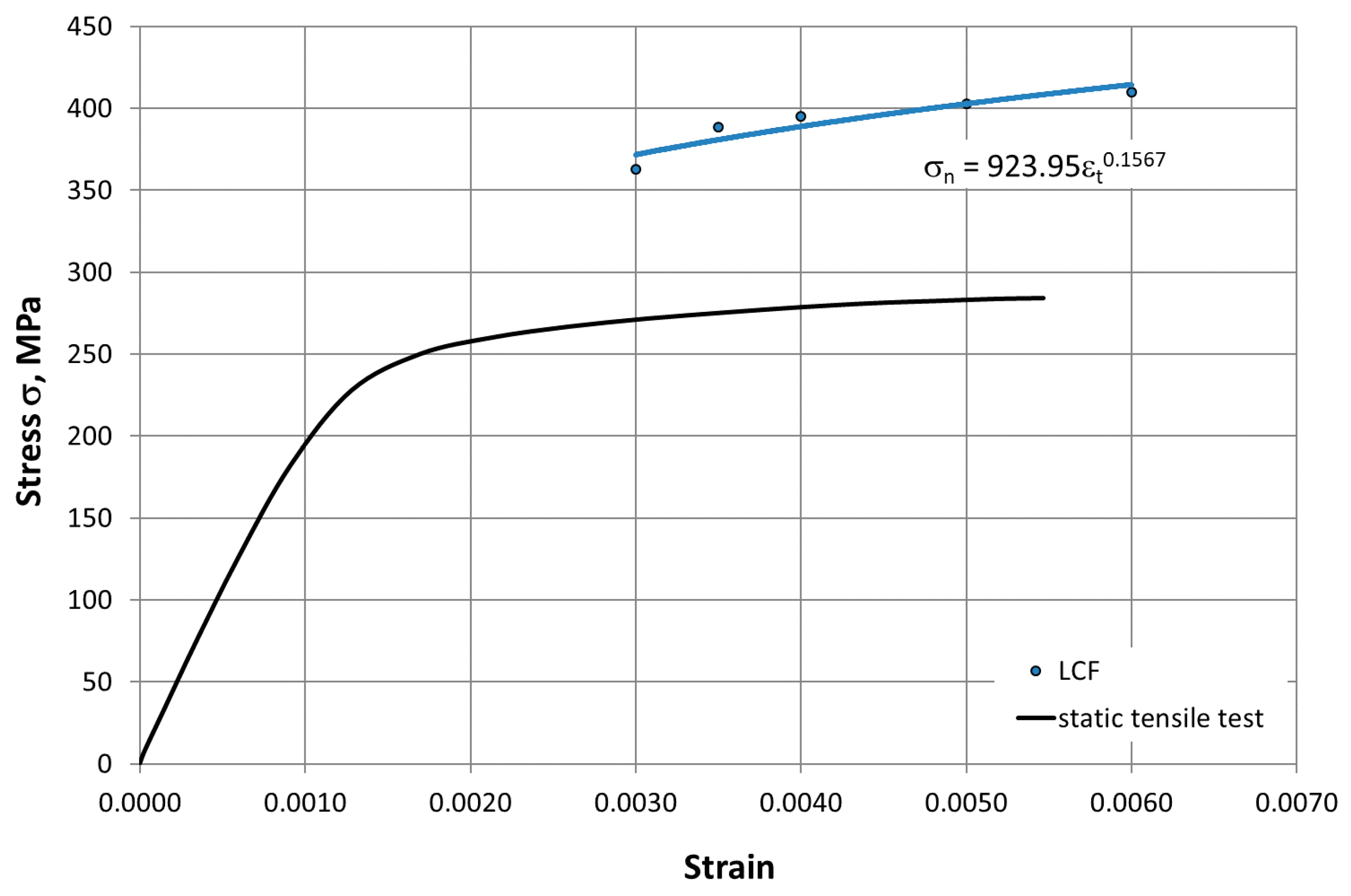
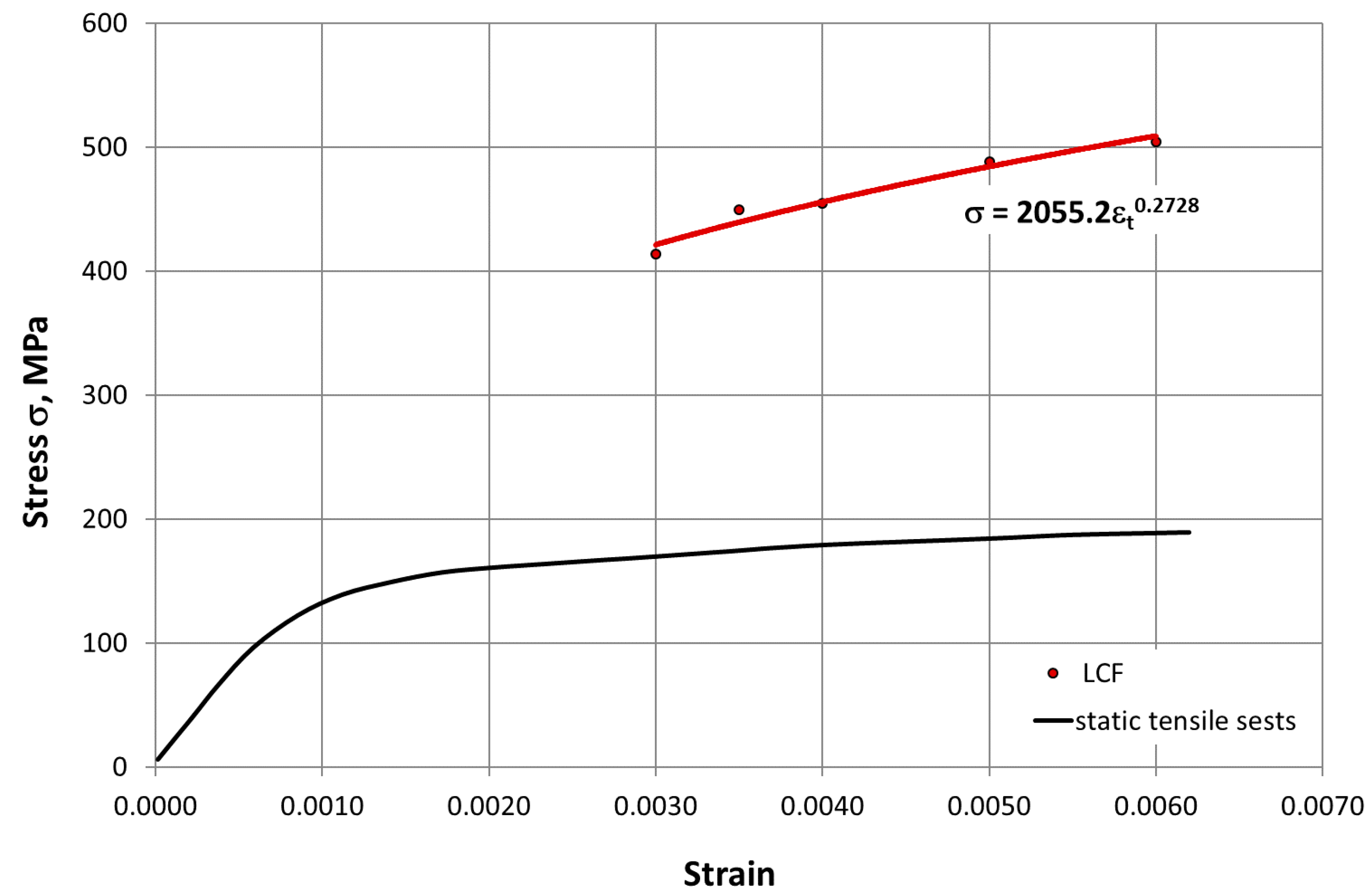
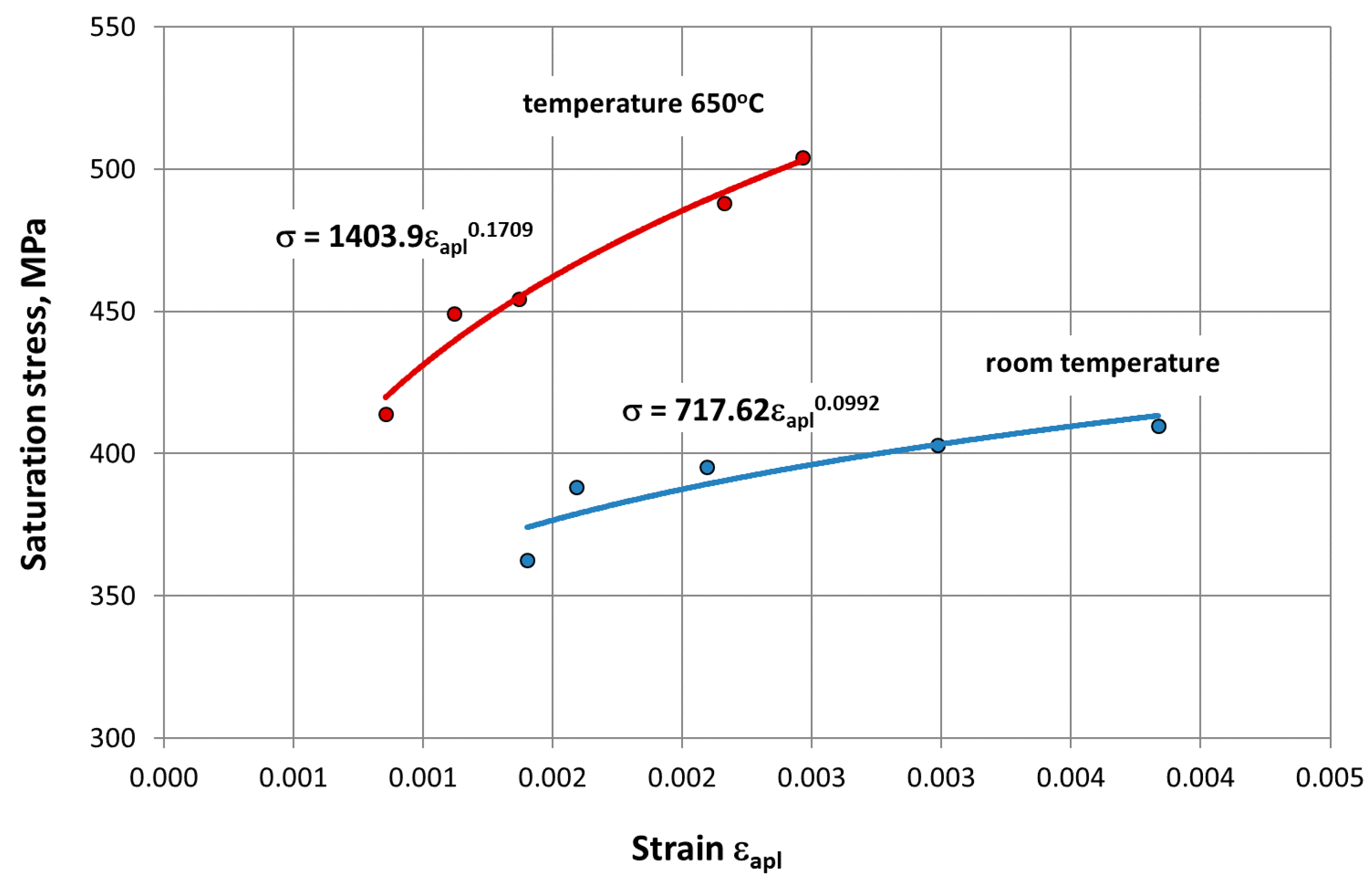

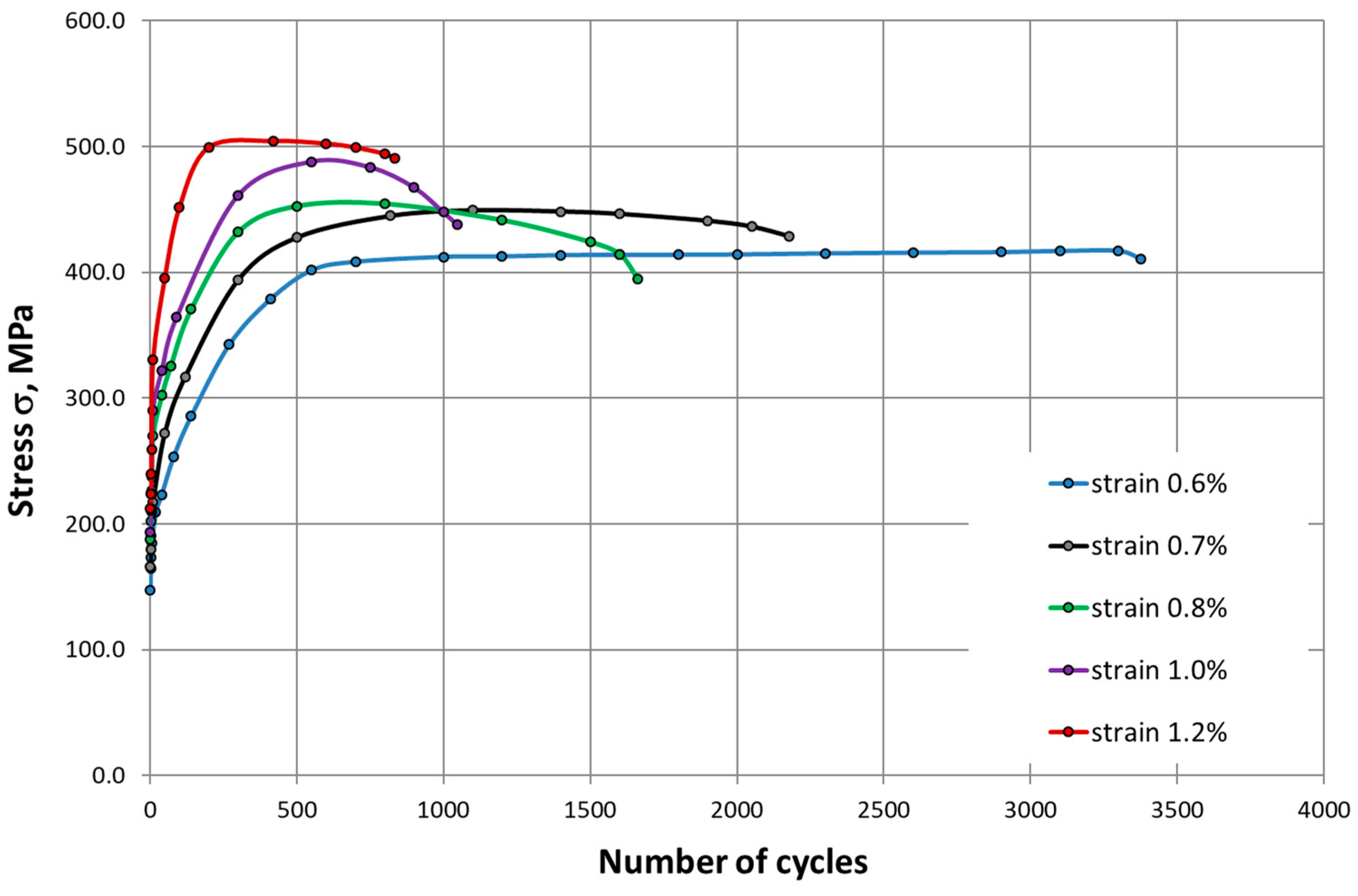
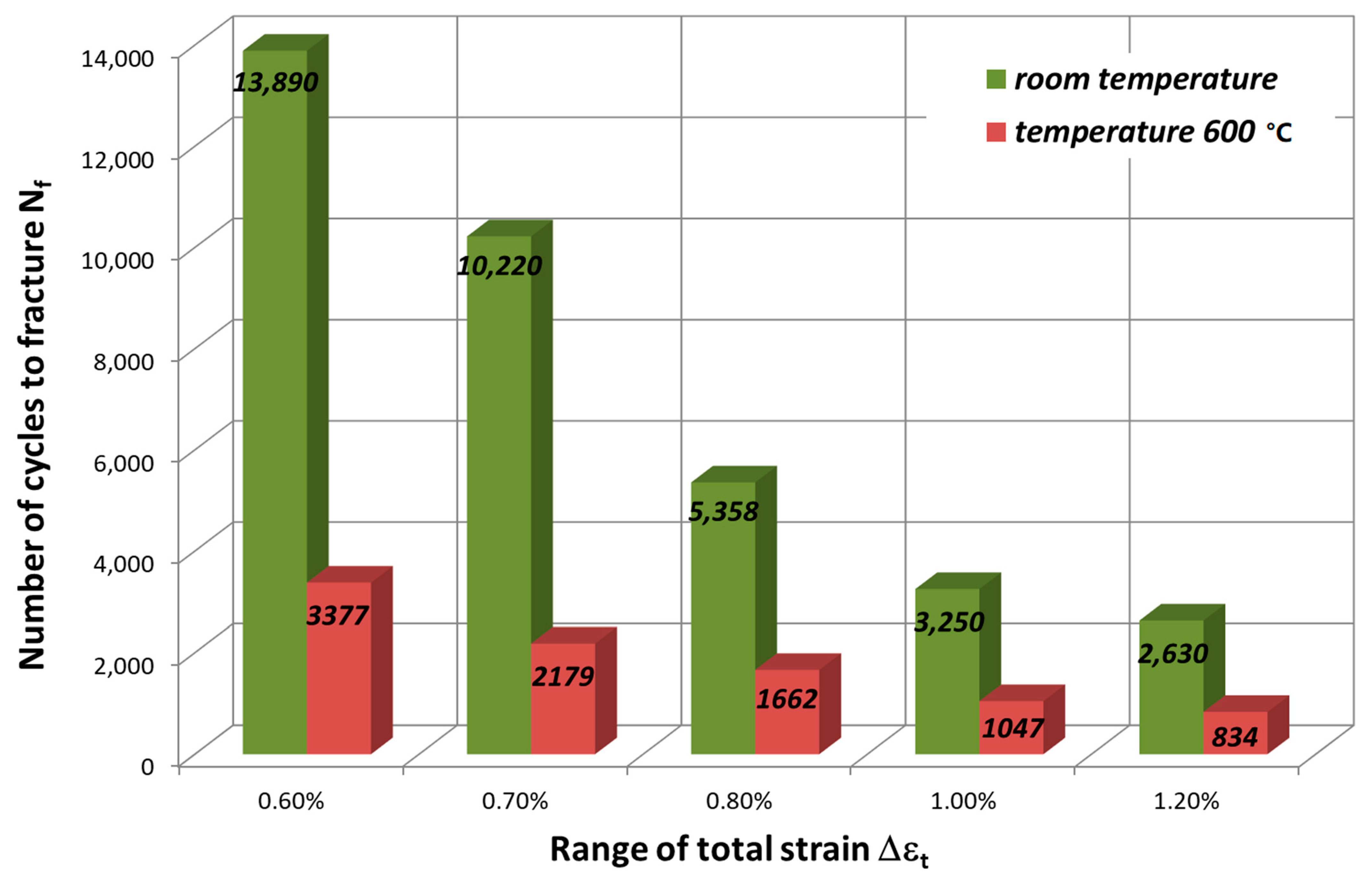
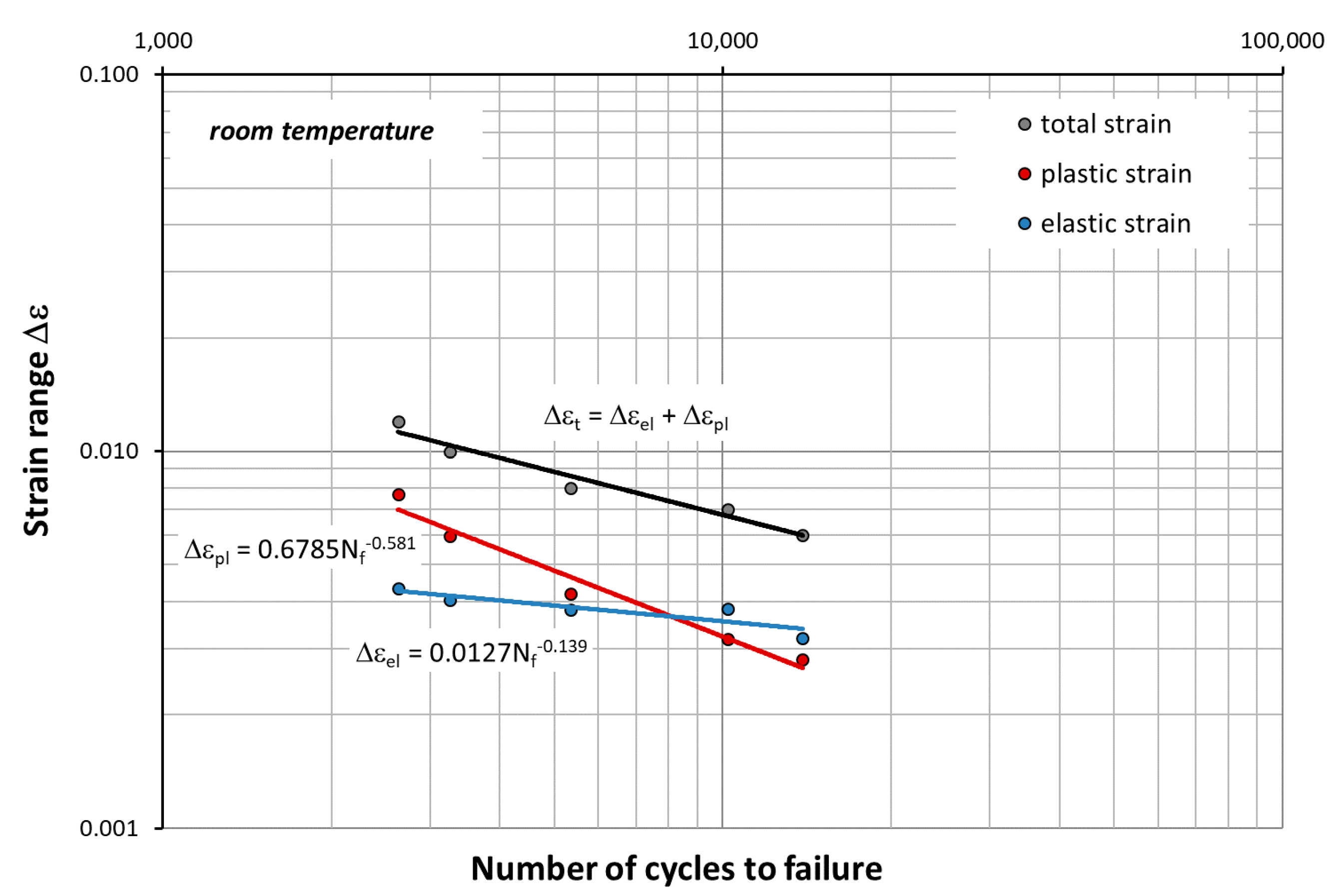

| Mechanical Properties | YS MPa | UTS MPa | A % | Z % |
|---|---|---|---|---|
| Room temperature | 271 | 624 | 59 | 49 |
| 650 °C | 146 | 431 | 70 | 52 |
| Δεt, % | εael | εapl | σan, MPa | Nf |
|---|---|---|---|---|
| 0.6 | 0.0016 | 0.0014 | 362.6 | 13,890 |
| 0.7 | 0.0019 | 0.0016 | 388.4 | 10,220 |
| 0.8 | 0.0019 | 0.0021 | 395.3 | 5358 |
| 1.0 | 0.0020 | 0.0030 | 402.9 | 3250 |
| 1.2 | 0.0022 | 0.0038 | 409.7 | 2630 |
| Δεt, % | εael | εapl | σan, MPa | Nf |
|---|---|---|---|---|
| 0.6 | 0.00214 | 0.00086 | 412.3 | 3377 |
| 0.7 | 0.00238 | 0.00112 | 449.2 | 2179 |
| 0.8 | 0.00263 | 0.00137 | 454.5 | 1662 |
| 1.0 | 0.00284 | 0.00216 | 478.0 | 1047 |
| 1.2 | 0.00354 | 0.00246 | 497.6 | 834 |
Publisher’s Note: MDPI stays neutral with regard to jurisdictional claims in published maps and institutional affiliations. |
© 2021 by the authors. Licensee MDPI, Basel, Switzerland. This article is an open access article distributed under the terms and conditions of the Creative Commons Attribution (CC BY) license (https://creativecommons.org/licenses/by/4.0/).
Share and Cite
Junak, G.; Marek, A.; Paduchowicz, M. Impact of Temperature on Low-Cycle Fatigue Characteristics of the HR6W Alloy. Materials 2021, 14, 6741. https://doi.org/10.3390/ma14226741
Junak G, Marek A, Paduchowicz M. Impact of Temperature on Low-Cycle Fatigue Characteristics of the HR6W Alloy. Materials. 2021; 14(22):6741. https://doi.org/10.3390/ma14226741
Chicago/Turabian StyleJunak, Grzegorz, Anżelina Marek, and Michał Paduchowicz. 2021. "Impact of Temperature on Low-Cycle Fatigue Characteristics of the HR6W Alloy" Materials 14, no. 22: 6741. https://doi.org/10.3390/ma14226741
APA StyleJunak, G., Marek, A., & Paduchowicz, M. (2021). Impact of Temperature on Low-Cycle Fatigue Characteristics of the HR6W Alloy. Materials, 14(22), 6741. https://doi.org/10.3390/ma14226741





